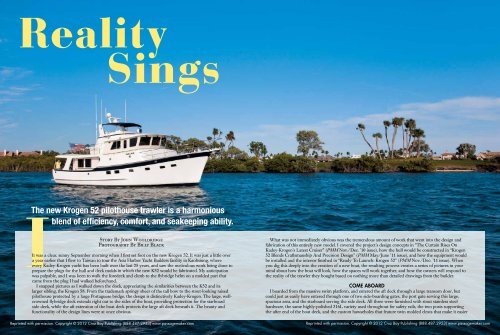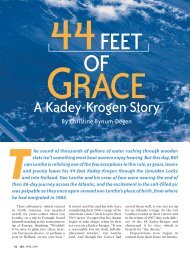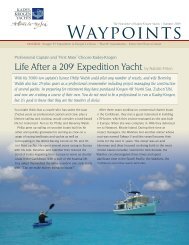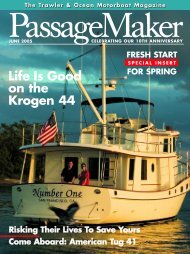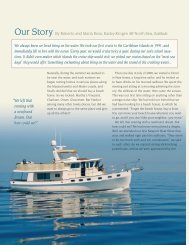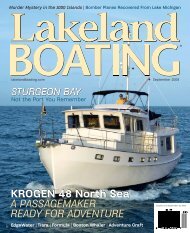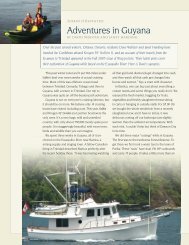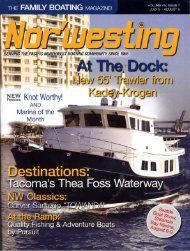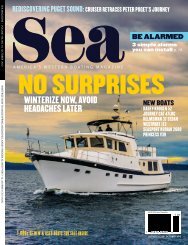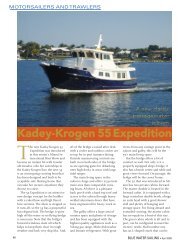The new Krogen 52 pilothouse trawler is a harmonious blend of ...
The new Krogen 52 pilothouse trawler is a harmonious blend of ...
The new Krogen 52 pilothouse trawler is a harmonious blend of ...
Create successful ePaper yourself
Turn your PDF publications into a flip-book with our unique Google optimized e-Paper software.
Reality<br />
Sings<br />
<strong>The</strong> <strong>new</strong> <strong>Krogen</strong> <strong>52</strong> <strong>pilothouse</strong> <strong>trawler</strong> <strong>is</strong> a <strong>harmonious</strong><br />
<strong>blend</strong> <strong>of</strong> efficiency, comfort, and seakeeping ability.<br />
Story By John Wooldridge<br />
Photography By Billy Black<br />
It was a clear, sunny September morning when I first set foot on the <strong>new</strong> <strong>Krogen</strong> <strong>52</strong>. It was just a little over<br />
a year earlier that I flew to Taiwan to tour the Asia Harbor Yacht Builders facility in Kaohsiung, where<br />
every Kadey-<strong>Krogen</strong> yacht has been built over the last 25 years, and saw the meticulous work being done to<br />
prepare the plugs for the hull and deck molds in which the <strong>new</strong> K<strong>52</strong> would be fabricated. My anticipation<br />
was palpable, and I was keen to walk the foredeck and climb to the flybridge helm on a molded part that<br />
came from the plug I had walked beforehand.<br />
I snapped pictures as I walked down the dock, appreciating the similarities between the K<strong>52</strong> and its<br />
larger sibling, the <strong>Krogen</strong> 58. From the trademark springy sheer <strong>of</strong> the tall bow to the stout-looking ra<strong>is</strong>ed<br />
<strong>pilothouse</strong> protected by a large Portuguese bridge, the design <strong>is</strong> d<strong>is</strong>tinctively Kadey-<strong>Krogen</strong>. <strong>The</strong> large, wellcrowned<br />
flybridge deck extends right out to the sides <strong>of</strong> the boat, providing protection for the starboard<br />
side deck, while the aft extension <strong>of</strong> the boat deck protects the large aft deck beneath it. <strong>The</strong> beauty and<br />
functionality <strong>of</strong> the design lines were at once obvious.<br />
What was not immediately obvious was the tremendous amount <strong>of</strong> work that went into the design and<br />
fabrication <strong>of</strong> th<strong>is</strong> entirely <strong>new</strong> model. I covered the project’s design concepts in “<strong>The</strong> Curtain R<strong>is</strong>es On<br />
Kadey-<strong>Krogen</strong>’s Latest Cru<strong>is</strong>er” (PMM Nov./Dec. ’10 <strong>is</strong>sue), how the hull would be constructed in “<strong>Krogen</strong><br />
<strong>52</strong> Blends Craftsmanship And Prec<strong>is</strong>ion Design” (PMM May/June ’11 <strong>is</strong>sue), and how the equipment would<br />
be installed and the interior fin<strong>is</strong>hed in “Ready To Launch: <strong>Krogen</strong> <strong>52</strong>” (PMM Nov./Dec. ’11 <strong>is</strong>sue). When<br />
you dig th<strong>is</strong> deeply into the creation <strong>of</strong> a <strong>new</strong> boat, the resulting process creates a series <strong>of</strong> pictures in your<br />
mind about how the boat will look, how the spaces will work together, and how the owners will respond to<br />
the reality <strong>of</strong> the <strong>trawler</strong> they bought based on nothing more than detailed drawings from the builder.<br />
COME ABOARD<br />
I boarded from the massive swim platform, and entered the aft deck through a large transom door, but<br />
could just as easily have entered through one <strong>of</strong> two side-boarding gates, the port gate serving th<strong>is</strong> large,<br />
spacious area, and the starboard serving the side deck. All three were furn<strong>is</strong>hed with stout stainless steel<br />
hardware, the same highly-pol<strong>is</strong>hed 316L variety used throughout for safety rails, the two posts supporting<br />
the after end <strong>of</strong> the boat deck, and the custom hawseholes that feature twin molded cleats that make it easier<br />
Reprinted <strong>52</strong> passagemaker.com with perm<strong>is</strong>sion. July/August Copyright 2012 © 2012 Cruz Bay Publ<strong>is</strong>hing (888.487.2953) www.passagemaker.com<br />
Reprinted with perm<strong>is</strong>sion. Copyright © 2012 Cruz Bay Publ<strong>is</strong>hing (888.487.2953) July/August 2012 www.passagemaker.com<br />
53
Left: <strong>The</strong> massive Portuguese bridge wrapping around the front <strong>of</strong> the <strong>Krogen</strong> <strong>52</strong> <strong>pilothouse</strong> features a hawse with cleats for easy<br />
fender positioning, a sturdy stainless steel grabrail, and storage lockers accessed from the back. Top right: Two well-spaced anchors<br />
on the bow are served by a Maxwell HWC 3500 windlass. Bottom right: Twin wing stations include throttle and shift binnacles,<br />
engine start and stop switches, and thruster controls.<br />
to tie and adjust multiple lines, or a line and a fender,<br />
without overlapping. For convenience, a Scandvik hot/<br />
cold freshwater handheld shower <strong>is</strong> located just inside<br />
the door, so rinsing <strong>of</strong>f the salt and sand can happen<br />
easily on the swim platform. <strong>The</strong> handcrafted standard<br />
teak planking under foot was meticulously laid and<br />
bedded, perfectly lined up across the large lazarette<br />
hatch in the center <strong>of</strong> the deck. Two large freeing ports,<br />
one in each corner, as well as several on the side, help<br />
ensure that the aft deck will drain quickly in case <strong>of</strong><br />
boarding seas—a requirement for the boat to have a<br />
CE Category Ocean A rating. One also makes a handy,<br />
low opening for neatly running the shorepower and TV<br />
cords from the inlets on the port side <strong>of</strong> the aft saloon<br />
bulkhead to the dock pedestal. <strong>The</strong>re was a freshwater<br />
bib and a washdown connection in th<strong>is</strong> area, as well.<br />
Walking down the side deck to starboard, I<br />
d<strong>is</strong>covered a recessed and vented fuel catchment with<br />
a dedicated fill port for each <strong>of</strong> the four tanks aboard.<br />
Well-placed, and beautifully ground and fin<strong>is</strong>hed,<br />
stainless handrails and deep bulwarks added a good<br />
grip for security when moving fore or aft under way.<br />
Where the teak planking ended and the GripTex<br />
non-skid-fin<strong>is</strong>hed fiberglass decks began, I passed the<br />
Dutch-style door to the galley and ascended the six<br />
stairs, passing the starboard Dutch-style <strong>pilothouse</strong> door<br />
and one <strong>of</strong> two high boarding gates, to the wing control<br />
station at the starboard corner <strong>of</strong> the Portuguese bridge<br />
walk-around deck. <strong>The</strong>re are two wing stations giving<br />
excellent views down the sides for easier handling, each<br />
equipped with engine start/stop buttons and throttles,<br />
and ABT TRAC thruster controls. Four large lockers<br />
accessible from the walk-around deck are provided to<br />
access the considerable stowage available within the<br />
Portuguese bridge structure. Excellent low stainless steel<br />
handrails topped the bridge, which was also partially<br />
protected overhead by the wide brow that extended<br />
forward over the reversed <strong>pilothouse</strong> windows.<br />
Access to the foredeck <strong>is</strong> through twin thick-section<br />
door panels, which are flanked by two molded bench<br />
seats with lockers for dock lines, hoses, and maybe<br />
a spare shorepower cord. <strong>The</strong> wide, clean foredeck<br />
<strong>is</strong> all on a single level and, along with the pulpit, <strong>is</strong><br />
well protected by significant bulwarks and by welded<br />
stainless steel safety rails with intermediate rungs to<br />
prevent anyone from slipping over the side. A second<br />
set <strong>of</strong> fresh and seawater washdown outlets, as well<br />
as a freshwater bib and inlets for shorepower and TV<br />
are found here, adding flexibility when power may be<br />
too far away from the aft deck. <strong>The</strong> heavily-molded<br />
bowsprit <strong>is</strong> configured with two stout rollers, and<br />
like the hydraulic Maxwell HWC 3500 windlass, <strong>is</strong><br />
set up above the deck level, where the foot switches<br />
were mounted on the boat I tested. Th<strong>is</strong> heavy-duty<br />
Reprinted with perm<strong>is</strong>sion. Copyright © 2012 Cruz Bay Publ<strong>is</strong>hing (888.487.2953) www.passagemaker.com<br />
Ergonomics play a vital part in the <strong>pilothouse</strong> layout, which <strong>is</strong> well proportioned to include room for twin helm seats, plenty <strong>of</strong> walkthrough<br />
room behind the seats to make it easy to access the Dutch-style doors on either side, and a comfortable ra<strong>is</strong>ed bench seat<br />
behind with a drop-down table that converts into a double berth for the <strong>of</strong>f-watch.<br />
horizontal unit has dual chain wheels and a single rope<br />
gypsy, covering virtually any combination <strong>of</strong> anchoring<br />
needs. To port, a watertight Freeman Marine anchor<br />
locker deck hatch opens to reveal molded steps down<br />
into the chain locker, which <strong>is</strong> divided by a substantial<br />
structure to keep rodes separated. <strong>The</strong> chain locker <strong>is</strong><br />
reinforced well, with aramid fibers, creating a strong<br />
coll<strong>is</strong>ion bulkhead.<br />
Stepping back through the twin opening doors, I<br />
continued around to the port side, past the other wing<br />
control station and the Dutch-style <strong>pilothouse</strong> door,<br />
and climbed the five stairs to the flybridge deck. A<br />
standing rail across the width <strong>of</strong> th<strong>is</strong> deck separated the<br />
area usable for entertaining from the area dedicated to<br />
the boat deck. <strong>The</strong> boat I tested had a Steelhead Marine<br />
ES1200 davit with hydraulic four-function crane and<br />
pedestal base. Although it was not fitted at the time <strong>of</strong><br />
our test, th<strong>is</strong> boat would receive a radar arch in lieu <strong>of</strong><br />
a mast, leaving room on the starboard side for a builtin<br />
fiberglass summer kitchen cabinet housing a SeaStar<br />
SSBQ-24 propane barbecue and a sink. <strong>The</strong>re was<br />
plenty <strong>of</strong> storage beneath for grilling equipment, or an<br />
Isotherm Cru<strong>is</strong>e 85 refrigerator. Just to starboard, and<br />
hidden by the upper helm structure, was an ABYCcompliant<br />
locker housing two 20-gallon LPG bottles.<br />
Three steps led up to the ra<strong>is</strong>ed helm station and an<br />
L-shaped bench with a table. <strong>The</strong> helm station included a<br />
tall Pompanette chair with a foot stand, a destroyer-type<br />
Edson stainless wheel, and a large console that included<br />
a flat for the engine controls and gauges, as well as the<br />
thruster controls, and a forward canted section large<br />
enough for twin multi-function screens. As I descended<br />
the stairs, I d<strong>is</strong>covered a vented locker that accessed<br />
voluminous storage beneath the helm deck structure.<br />
STEP INTO THE PILOTHOUSE<br />
Entering the <strong>pilothouse</strong> through the portside door,<br />
I particularly appreciated the v<strong>is</strong>ibility from the helm,<br />
which swept through nearly 270 degrees. <strong>The</strong>re were<br />
great wood handrails atop the chart table (with chart<br />
drawers below) immediately to my left and right atop<br />
the ra<strong>is</strong>ed bench seat/watch berth, as well as on the far<br />
side <strong>of</strong> the helm console, which stretches the full width<br />
<strong>of</strong> the <strong>pilothouse</strong>. <strong>The</strong> table serving the bench seat will<br />
convert to a double for the <strong>of</strong>f-watch. <strong>The</strong> walkway<br />
between the helm and the ra<strong>is</strong>ed bench seat aft was<br />
carefully created to allow room for two helm chairs<br />
with plenty <strong>of</strong> space to pass from side to side.<br />
<strong>The</strong> main breaker panel was positioned just to port <strong>of</strong><br />
the custom wood (stainless <strong>is</strong> standard) steering wheel,<br />
beneath the chart table, protected by opening doors<br />
with slightly tinted glass inserts for easy viewing and low<br />
glare. Per ABYC recommendations, the panel <strong>is</strong> locked<br />
by bolt and key, making accidental access just about<br />
impossible. Two separate panels are found to starboard<br />
for the marine electronics switches. <strong>The</strong> woodwork in<br />
Reprinted with perm<strong>is</strong>sion. Copyright © 2012 Cruz Bay Publ<strong>is</strong>hing (888.487.2953) www.passagemaker.com
<strong>Krogen</strong> <strong>52</strong><br />
where I found myself immediately in an open <strong>of</strong>fice<br />
area well equipped with a large desk, book shelves,<br />
and plenty <strong>of</strong> drawers, some dedicated for filing. Two<br />
large opening Manship ports with screens were nicely<br />
set into the teak ceiling strips on the hull side. Just<br />
ahead, an ASKO washer/dryer was neatly installed in<br />
a locker in the companionway. <strong>The</strong> boat I tested had<br />
the standard layout <strong>of</strong> a large master forward with an<br />
<strong>is</strong>land queen berth, and a guest stateroom to starboard,<br />
across from the <strong>of</strong>fice, both with private access to<br />
head compartments. <strong>The</strong>re are other layouts available,<br />
including one with a mid-ship master. Vimar CO<br />
detectors are standard.<br />
the <strong>pilothouse</strong> was flawlessly joined<br />
and fin<strong>is</strong>hed teak (cherry <strong>is</strong> available),<br />
with a hand-laid teak and spruce<br />
sole. Two teak overhead grabrails<br />
were positioned for the best stability<br />
ass<strong>is</strong>tance underway.<br />
<strong>The</strong> electronics console <strong>is</strong> spacious<br />
enough for the largest screens you<br />
can imagine, and there <strong>is</strong> an overhead<br />
electronics console in case your budget<br />
and imagination are larger than the<br />
lower space available. Panels for the<br />
generator, holding tank indicator, and<br />
SeaLand Tank Manager are mounted<br />
at the end <strong>of</strong> the bench seat, for quick<br />
v<strong>is</strong>ual access when using the stairs<br />
leading down to the saloon.<br />
LIVING COMFORTABLY<br />
<strong>The</strong>re are six straight steps with real<br />
household r<strong>is</strong>ers and treads leading<br />
down to the main cabin level, which<br />
includes the galley and the saloon.<br />
Large powder-coated Diamond Sea Glaze windows,<br />
six <strong>of</strong> which slide open and include screens, surround<br />
the entire area, with excellent views on both sides and<br />
through the aft bulkhead starboard corner. <strong>The</strong> welded<br />
aluminum Diamond Sea Glaze double door leading<br />
to the aft deck <strong>is</strong> weather tight, and there <strong>is</strong> a hidden<br />
screen door included for times when natural ventilation<br />
<strong>is</strong> desirable. Teak cabinetry, window valences, and<br />
Top: Large Diamond Sea Glaze side windows, six <strong>of</strong> which slide open and are<br />
screened, provide ample natural light and ventilation, as well as excellent views in<br />
the saloon. Above: <strong>The</strong> Dutch-style door leading from the galley to the starboard side<br />
deck eliminates the need to exit through the aft saloon doors.<br />
built-in furniture matched the high quality <strong>of</strong> fit and<br />
fin<strong>is</strong>h I observed in the <strong>pilothouse</strong>, exuding a traditional<br />
warmth that <strong>is</strong> fitting in the K<strong>52</strong>. For a contemporary<br />
touch, Corian (or optionally, granite) graces the tops <strong>of</strong><br />
numerous lockers and counters throughout the boat.<br />
<strong>The</strong> galley <strong>is</strong> replete with stainless steel fin<strong>is</strong>h<br />
appliances from GE and Jenn-Air as standard<br />
equipment, as well as with a Viking LPG range and<br />
Reprinted with perm<strong>is</strong>sion. Copyright © 2012 Cruz Bay Publ<strong>is</strong>hing (888.487.2953) www.passagemaker.com<br />
Top: Two screened stainless steel Manship opening ports help light the guest stateroom. Above: <strong>The</strong><br />
forward master stateroom has abundant storage built into the <strong>is</strong>land queen berth, including a bulk<br />
storage compartment beneath the mattress. Right: <strong>The</strong> private head compartment serving the master<br />
stateroom features a large separate shower and plenty <strong>of</strong> storage.<br />
oven. Storage cabinets are numerous above and below<br />
the main countertop, and the space between seems<br />
perfect for bracing oneself against the movement <strong>of</strong> the<br />
boat underway. Having a Dutch-style door opening on<br />
the starboard side deck adds the possibility <strong>of</strong> excellent<br />
ventilation when the galley <strong>is</strong> heating up, as long as it <strong>is</strong><br />
used with an awareness <strong>of</strong> prevailing conditions.<br />
Four steps down lead to the accommodations level,<br />
THE ENGINE ROOM<br />
Whether you opt for a standard single or optional<br />
twin John Deere diesels, there <strong>is</strong> ample space in the<br />
engine room for underway routine maintenance and<br />
regular checks. Inside the watertight door at the forward<br />
entrance, headroom <strong>is</strong> 6 feet 3 inches and progresses<br />
to 5 feet 9 inches further aft. Access to the strainers,<br />
fuel/water separators, and engine fluid checkpoints are<br />
all near the front <strong>of</strong> the compartment. <strong>The</strong> standard<br />
Northern Lights genset <strong>is</strong> located to starboard and there<br />
<strong>is</strong> enough space for a<br />
second genset to port.<br />
<strong>The</strong> single engine<br />
installation has 16<br />
Lifeline AGM batteries:<br />
4 being 12VDC units<br />
ganged in pairs—making<br />
24VDC—for engine and<br />
genset starting, and 12<br />
being 6VDC—300Ah<br />
units devoted to 24VDC<br />
ship’s service. Batteries<br />
are enclosed in fiberglass<br />
boxes with ventilation<br />
per ABYC guidelines.<br />
Electrical service includes<br />
Balmar alternators with<br />
external regulators, 190<br />
amps and 80 amps,<br />
respectively. Charles<br />
Industries’ 60-amp<br />
battery charger and an<br />
<strong>is</strong>olation transformer are<br />
also part <strong>of</strong> the electrical<br />
equipment, along with a Magnum Energy 4000-watt<br />
inverter/battery charger.<br />
<strong>The</strong> insulated copper plumbing runs and the tinned<br />
wiring electrical runs were neat and clean—some <strong>of</strong> the<br />
best available. Pyrotek Sorberflex sound insulation was<br />
used extensively to attenuate engine room no<strong>is</strong>e and<br />
vibration, which showed up in my measurements.<br />
Reprinted with perm<strong>is</strong>sion. Copyright © 2012 Cruz Bay Publ<strong>is</strong>hing (888.487.2953) www.passagemaker.com
<strong>Krogen</strong> <strong>52</strong><br />
KROGEN <strong>52</strong><br />
THE TEST<br />
That perfect September day I first<br />
stepped aboard the K<strong>52</strong> also proved<br />
to be a light-winded day—not exactly<br />
the kind <strong>of</strong> conditions in which you’d<br />
like to test a bluewater-capable <strong>trawler</strong>.<br />
Yet run we did, verifying the numbers<br />
that Kadey-<strong>Krogen</strong> publ<strong>is</strong>hes on their<br />
website: a top speed <strong>of</strong> 9.6 knots at<br />
2350 rpm, burning approximately<br />
10.2gph, a cru<strong>is</strong>ing speed <strong>of</strong> 8 knots<br />
at 1500 rpm, burning roughly 3.7gph.<br />
At ocean cru<strong>is</strong>ing speeds <strong>of</strong> 7 knots,<br />
Kadey-<strong>Krogen</strong> estimates a range <strong>of</strong><br />
3,300nm with a 10-percent fuel reserve.<br />
At coastal cru<strong>is</strong>ing speeds <strong>of</strong> 9 knots,<br />
their estimate <strong>is</strong> 1,700nm. Sound<br />
levels in the <strong>pilothouse</strong>, recorded<br />
with the doors and windows shut and<br />
the genset running, started at 55dBA<br />
at idle, rose to 61dBA at 8 knots,<br />
and ended at 67dBA at wide open<br />
throttle—very quiet, indeed, especially<br />
for an empty boat without any carpet<br />
or owner’s possessions aboard. At<br />
one point, I ducked down to the saloon and measured<br />
67dBA at 8 to 9 knots, still a real<strong>is</strong>tic level for those who<br />
might be cooking or relaxing underway.<br />
Interestingly, Kadey-<strong>Krogen</strong> personnel ran K<strong>52</strong> hull<br />
number three, powered by only one <strong>of</strong> the boat’s twin<br />
John Deere 121hp diesels, to simulate performance with<br />
one engine <strong>of</strong>fline, and found that at 2000 rpm, fuel<br />
Top: Looking through the aft watertight door <strong>of</strong> the engine compartment into the<br />
lazarette, the care and organization given to mounting and routing systems <strong>is</strong><br />
evident. Above: Kadey-<strong>Krogen</strong> Vice President Larry Polster performs a routine<br />
fluid check prior to start-up near the front end <strong>of</strong> the engine compartment, where<br />
headroom <strong>is</strong> 5 feet 9 inches.<br />
burn was 3.7gph and speed was 7.5 knots.<br />
Handling underway and around the docks was<br />
notable, but then again, our conditions were near<br />
perfect. Not being sat<strong>is</strong>fied with our near-calm water<br />
conditions, I called Mike Warren, the owner <strong>of</strong> Suite<br />
Judy, K<strong>52</strong> hull number two, and asked about h<strong>is</strong><br />
delivery in the spring <strong>of</strong> th<strong>is</strong> year.<br />
LOA 57'9"<br />
LWL 47'6"<br />
BEAM 17'9"<br />
DRAFT 5'5" (single engine,<br />
half load)<br />
DRAFT 4'6" (twin engines,<br />
half load)<br />
DISPLACEMENT 70,000 lb. (half load)<br />
BRIDGE CLEARANCE 24'8"/15'9"<br />
(mast up/down)<br />
ENGINE Single 231hp John Deere<br />
6068AFM75 (standard)<br />
ENGINES Twin 121hp John Deere<br />
4045TFM75(optional)<br />
GENERATOR 16kW Northern Lights<br />
FUEL 1,400 U.S. gal.<br />
WATER 400 U.S. gal.<br />
HOLDING TANK 125 U.S. gal.<br />
GRAY WATER 125 U.S. gal.<br />
MAXIMUM SPEED 9.6 knots (standard<br />
power, half load)<br />
CRUISE SPEED 7 to 9 knots (standard<br />
power)<br />
RANGE AT CRUISE SPEED 3,300nm (at 7 knots)<br />
RANGE AT CRUISE SPEED 1,700nm (at 9 knots)<br />
DESIGNER & Builder Kadey-<strong>Krogen</strong> Yachts<br />
BASE PRICE Price On Request<br />
•<br />
For more information:<br />
Kadey-<strong>Krogen</strong> Yachts<br />
610 NW Dixie Highway<br />
Stuart, FL 34994<br />
800.247.1230<br />
www.kadeykrogen.com<br />
“We left Fort Pierce inlet at 2 p.m. on May 9, and 49<br />
hours later we put in at Southport on the Cape Fear<br />
River,” Warren said. “We would have been there sooner,<br />
but we lost an hour hauling in a huge mahimahi, which<br />
was dinner that evening. We had planned to go into<br />
Morehead City, but it was blowing 28 to 35 knots with<br />
really big following seas, up to 12 footers. It looked like<br />
we would get into Morehead around midnight in those<br />
same high winds, so I made the dec<strong>is</strong>ion to head for<br />
Southport, arrive in the afternoon, clean up the boat,<br />
and relax a little. <strong>The</strong> boat handled the big seas great,<br />
and the TRAC stabilizers were outstanding. We ran a<br />
second genset, a 6kW Northern Lights all the time and<br />
burned just below 5gph combined. We also appreciated<br />
the black panels overhead in the <strong>pilothouse</strong>, because it<br />
really cut down on the glare.”<br />
One <strong>of</strong> Warren’s crew members compiled a video <strong>of</strong><br />
highlights from the trip, so you can see the great f<strong>is</strong>h<br />
and the large waves at: www.kadeykrogen.com/videos/<br />
playvideo.php?id=33.<br />
Watching all the fun they made me sorry I didn’t get<br />
to take Warren up on a delivery ride th<strong>is</strong> year, but it was<br />
also a testament to the efforts <strong>of</strong> the entire Kadey-<strong>Krogen</strong><br />
and Asia Harbor Yacht Builders team members, to see<br />
the idea that was once only on paper become a reality<br />
resulting in the efficient, comfortable <strong>Krogen</strong> <strong>52</strong>.<br />
Reprinted with perm<strong>is</strong>sion. Copyright © 2012 Cruz Bay Publ<strong>is</strong>hing (888.487.2953) www.passagemaker.com<br />
Reprinted with perm<strong>is</strong>sion. Copyright © 2012 Cruz Bay Publ<strong>is</strong>hing (888.487.2953) www.passagemaker.com


